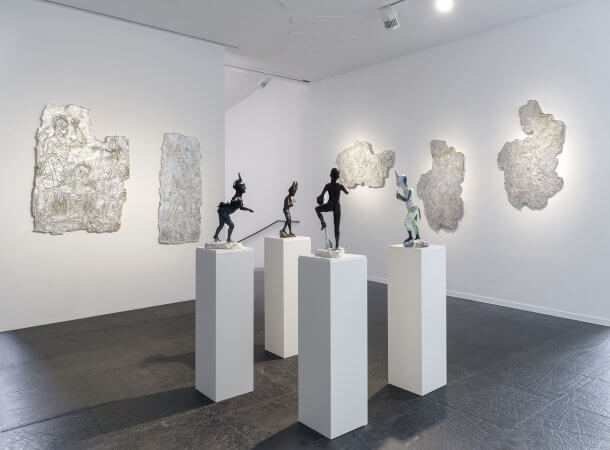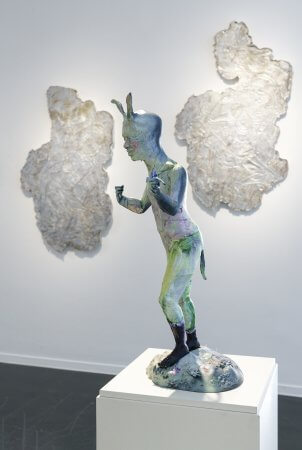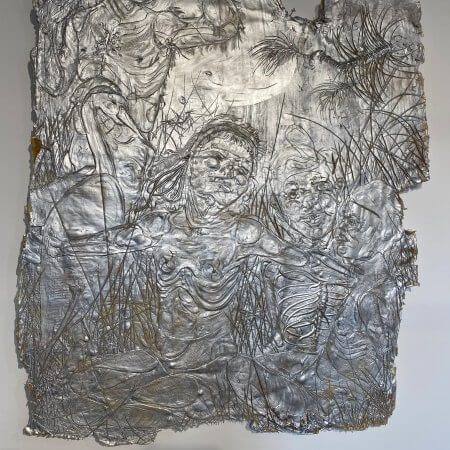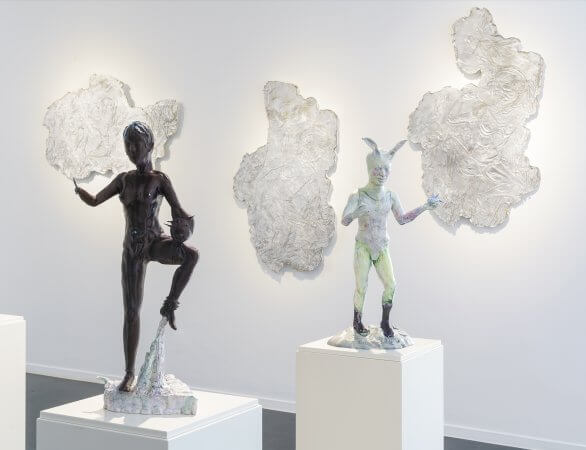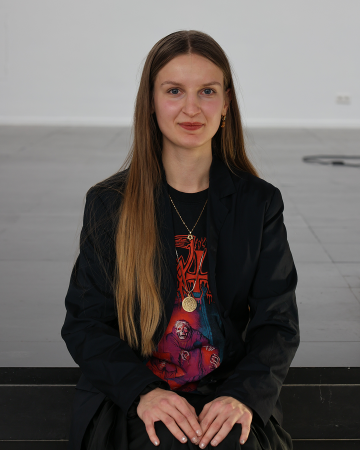Lisa-Sophie Gehrmann
Horizontsucher, 2023
Five latex reliefs
120 x 80 cm, 160 x 130 cm, 50 x 140 cm
Narrenfreiheit, 2023
Four 3D print, oil paint, plaster
50 x 27 x 20 cm, 50 x 22 x 20 cm, 50 x 26 x 27 cm
Courtesy the artist
With its origins in drawing, Lisa-Sophie Gehrmann’s artistic practice is marked by the eclectic use of different ideas, techniques, materials, stylistic elements and pictorial motifs. Whether pencil on paper, glazed ceramics with open forms, reliefs, 3D drawings or 3D prints, her visual worlds are always inhabited by fantastical figures. These beings are the result of a world-making practice that separates and uses them as fragments of different frames of reference. Many elements derive from a fictional surreal world, while others possess symbolic features and embody social customs or human qualities that fascinate the artist.
Her figures are always set in an implied natural environment and often accompanied by insect-like animals. They are prehistoric crabs, living fossils, the oldest known living animal species on our planet. The anatomy of both the animals and humans is strikingly drawn. Particularly eye-catching is the design of the bones, which in Gehrmann’s work do not stand for mourning or death, rather eternity. The artist takes up the motif of the faun in the three-dimensional individual figures. This figure from Greek mythology stands as a deity of nature and the forest, a hybrid creature between man and animal. Glitteringly located between faun, satyr, pan and jester, their beings display a self-confident sensuality and eroticism that seem to celebrate their freedom and subversiveness.
Gehrmann draws archetypes as primal images that are associated with certain characteristics. Her fascination is for the instinctive in people, their irrationality, and for marginal figures in society. Some wear head covering reminiscent of Phrygian caps. These have historical connotations, often symbolising contradiction and independence. The cap existed in a wide variety of cultural contexts, from ancient Rome, where it was worn by freed slaves, to the French Revolution as an allegory of freedom and the republic. Other figures can be recognised as Till Eulenspiegel or as jesters. In all cultures, the court jester occupied a special status as fool, allowing him to criticise and satirise existing conditions with impunity. Outsiders to society, jesters embody the spirit of freedom of expression by addressing society’s ills in a humorous way.
Linking up with them are the child-like figures in Gehrmann’s drawings. Children, too, cannot be categorised in the way society operates, as they as yet have neither historical memory nor social imprint. With their often-unprejudiced attitude, they are free in their actions.
A presentation was conceived for the Frankfurter Kunstverein that provides insight into new experiments and Gehrmann’s current working methods, involving latex reliefs and sculptures created with 3D printers. With haptics always playing a role, the latex reliefs continue a practice the artist has been carrying out for several years. Carving her drawings on fresh clay plates, she then casts them with latex. The resulting negative moulds give the drawing lines a raised and three-dimensional look. The latex reliefs are then finished with silver paint, creating a monochrome aesthetic redolent of fossils.
This practice of drawing on clay brings to mind early techniques of writing on surfaces. As far back as early antiquity, people carved writing and drawings into clay slabs with simple tools, making them the first forms of human record to stand the test of time.
Lisa-Sophie Gehrmann (*1999 in Gera, DE) has studied at the Hochschule für Gestaltung Offenbach with Prof. Manfred Stumpf since 2019, with a focus on ceramics and drawing. In 2021, she received scholarships from the Cusanus and Johaness-Mosbach Foundations. Lisa-Sophie Gehrmann presented her work at the Haus der Stadtgeschichte, Offenbach am Main (DE) and participated in the exhibition project Frankfurter Kunst Vertrieb by the collective Magma Maria in 2021, which was presented at the Frankfurter Kunstverein.

